First performed by Iréne Bordoni (1928).
First recorded and released by Irving Aaronson & His Commanders (1928).
Hit versions by The Paul Whiteman Orchestra (US #5 1929), Dorsey Brothers & their Orchestra (US #9 1929).
From the wiki: “‘Let’s Do It, Let’s Fall in Love’ (also known as ‘Let’s Do It (Let’s Fall in Love)’ or simply ‘Let’s Do It’) was written in 1928 by Cole Porter. It was introduced in Porter’s first Broadway success, the musical Paris (A Play with Songs) (1928), by French chanteuse Irène Bordoni for whom Porter had written the musical as a starring vehicle. The song was later used in the English production of Wake Up and Dream (1929) and was also used as the title theme music in the 1933 Hollywood movie, Grand Slam.
“Irving Aaronson & His Commanders (who also performed as the ‘house band’ for the Broadway production of Paris) was the first group to release a commercial recording, in October 1928 on the Victor label. The following year, a young Bing Crosby recorded two versions of ‘Let’s Do It’ for two different but popular bands. The first was an uncredited performance in 1929 with The Paul Whiteman Orchestra. Crosby’s subsequent recording later that year with the Dorsey Brothers, however, did list him on the label as the featured vocalist.

